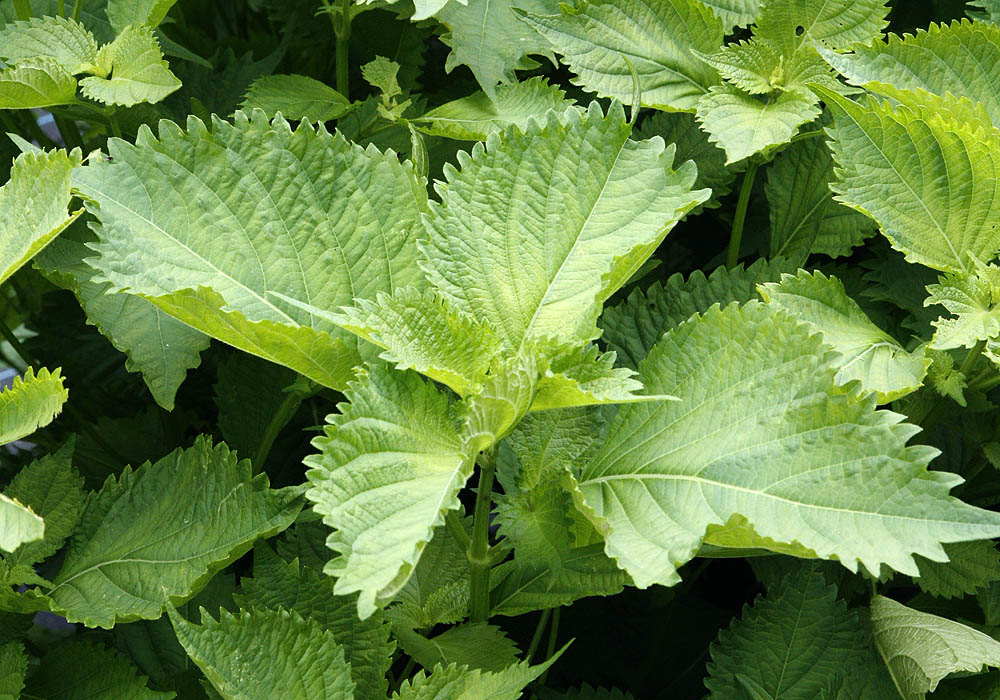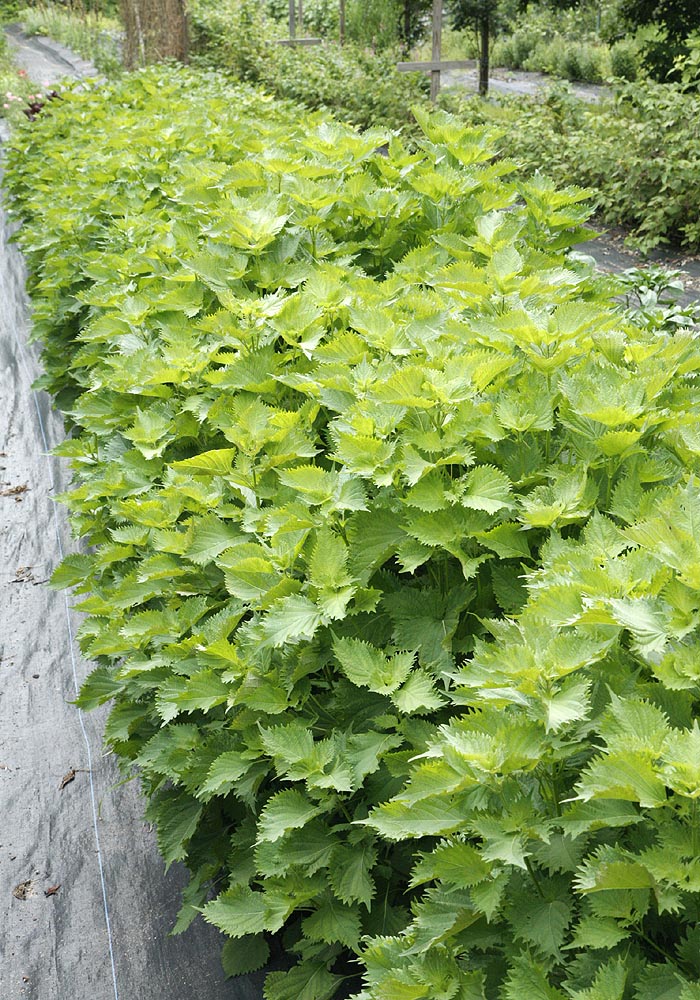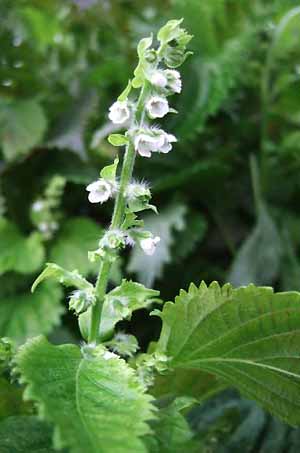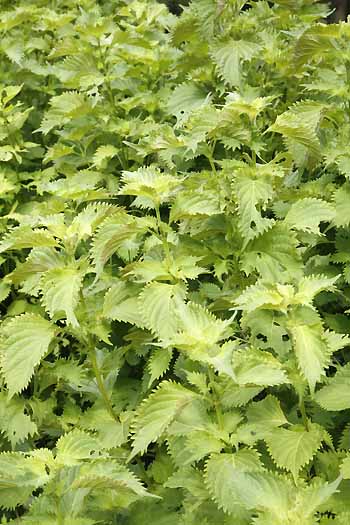Perilla is a lovely plant both as an ornamental and as a food plant. Ornamentally
it is grown for its interesting leaves which are crinkly and deeply veined making
them stand out if used in a flower bed. Since it can reach 4 feet in height
it makes a good back border plant. It is very aromatic and the slightest touch
will set off the scent, so don't plant it too close to your deck unless you
love the smell. It's a tough plant, it does very well in hot sunny locations
but can also thrive in some shade. It needs very little maintenance once established
and as an ornamental its pretty drought tolerant. More water is needed if you
want to harvest the leaves.
Wildlife don't eat it. Deer and rabbits avoid it. Since it requires short days
to flower it produces blooms late in the fall when most other plants have ceased
blooming. This makes it ideal for gardens that encourage wildlife as it is a
source of nectar when there is little else available. Honey bees, native bees
and butterflies flock to the flowers.
There are two major kinds red and green. Each have their own particular aroma
and flavor but the basic appearance is mostly the same.
Description of Green Perilla (Perilla frutescens).
Perilla is hardy to zone 8 (some say 10) In these zones and higher it can be
grown as a perennial. In zones above 8 it is grown as an annual. Green perilla
is a very attractive plant with bright to mid green leaves up to four inches
long. The leaves have a heavily serrated undulating border and are deeply veined
and wrinkled giving them an interesting texture. The plant develops several
tall bushy stems with luxuriant leaf growth that can reach 3 feet in height,
more if conditions are really favorable. In late summer tall flower spikes arise
from the ends of the branches. These can be over a foot long and are covered
with small almost tubular flowers that are white to pinkish or mottled with
pink. They are not very showy but the butterflies and native bees love them.
The plant is grown mainly for its interesting foliage.
Green perilla or true shiso is a very aromatic plant. The aroma is strong and
even just moving the stems will create a strong scent in the air. The flavor
is hard to describe. It is a combination of cinnamon, anise, basil and some
say cloves with a hint of citrus all wrapped into one. It's pretty strong: even
chewing a little off one leaf can be enough for some people.
Plants similar to Perilla
Perilla looks rather like an overgrown nettle or a coleus plant. It is a member
of the mint family - as are the others - so the appearance is understandable.
Some of its common names reflect this resemblance however its not a mint and
not a coleus or a nettle.
Location and Care of Perilla.
Both green and red perilla are pretty tough plants. They can survive in bright
hot sunshine but will also do quite well in semi shade. They will grow in almost
any soil type that is well drained. Do not do well in heavy clay or waterlogged
soils. Do not need any fertilization but add some organic material to the soil
before planting and this should be enough. Once established the plant is fairly
drought tolerant and can go some time without water. However if leaf production
is required for food some water is needed: a soaker hose at the base of the
plants is ideal. For prolific leaf growth some water every day is best; for
ornamental use twice a week should be sufficient unless there is very little
rain.
If bushy plants are desired pinch off the tops to encourage branching. Flowers
can be pinched off if leaf production is desired. If allowed to flower, cut
flower stalks when finished to prevent self seeding. Plant will seed prolifically
if allowed.
The plant
requires short days to flower so provides flowers late in the year
when many other plants have ceased flowering. This is ideal for many insects
and especially honey bees which love the plant.
Growing Perilla from seed.
Can be sown directly in the ground or started indoors for earlier production.
Seeds germinate best around 20 C (68 F).
Sowing outdoors. Prepare bed and surface sow the seeds. They may be very
lightly covered if desired. For information about growing with few weeds see
herb bed preparation.
Starting indoors Seed is fairly large so sowing in individual
pots or cell flats is recommended. Surface sow or only lightly cover seeds.
See general growing instructions
for more detailed information.
Harvesting Perilla (Perilla frutescens).
Leaves can be harvested once the plants reach a foot in height. Pinch out the
tops of the plant to encourage the plant to bush out. This produces more leaves.
Young leaves tend to have a less spicy flavor while older leaves have more bite.
Whole branches can be removed if more leaves are needed.
If drying for later use, take whole branches of leaves just before flowering
when the flavor is at its peak. Cut the whole stems, bunch and hang upside down
in a warm dry dark space until dry. Then strip the leaves from the stalks and
store in air tight containers in a cool dark place to retain the flavour as
long as possible.
If harvesting seed use a large bin to collect whole branches at one time.
Edible Uses of Perilla (Perilla frutescens).
This plant is extremely popular in Japanese and Korean cooking where the leaves
are used fresh or pickled to flavor rice, fish, soups and vegetables as garnish
and as an onigiri wrap. Chopped they are used in stir fries, tempura, tofu,
with cold noodles and salads. It is used by many Japanese when preparing Western
dishes as a substitute for sweet basil.
Seedlings are added to salads, older leaves are used as a garnish or flavoring
in many dishes. The older leaves are also salted and used as a condiment for
tofu and as a garnish for tempura; it also makes a nice pesto. They are one
of the ingredients in 'Shichimi' or 'seven spice' mixture. Leaves from purple/red
cultivars are used to color preserved fruits especially pickled plums. The seeds
are preserved in salt or are used as a spice in pickles, tempura. miso and crushed
and added to mustard. Apparently the seeds of the red variety are preferred
for this.
Essential oils extracted from the plant are also used as a food flavoring in
candies and sauces.
Medicinal Uses of Perilla (Perilla frutescens)
Virtually all the plant is used in Oriental medicine. It is considered a warming
herb and has a lot of different properties. The leaves are used to treat colds,
chest stuffiness, vomiting, abdominal pain, lung infections, influenza prevention
and many others. The juice of the leaves is applied to cuts and wounds. The
seeds are used internally in the treatment of asthma, colds and chills, nausea,
abdominal pain, food poisoning and allergic reactions (especially from seafood),
bronchitis and constipation.
The crushed leaves rubbed onto the skin serve as an insect repellant; it is
reported to be especially effective against ticks
Perilla Oil is obtained by pressing the seeds of perilla, which contain 35 to
45 percent oil. It is most commonly used in Asia where it is valued more for
its medicinal benefit as it is a very rich source of omega-3 fatty acid.
Other uses of Perilla.
The oil is also









